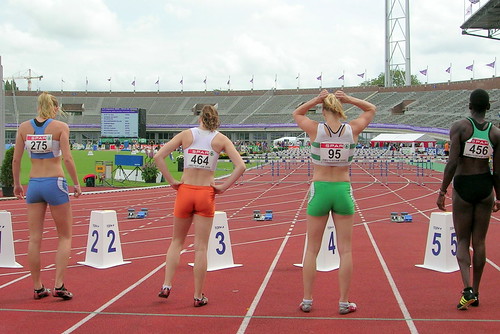Let's face it. Sports fans overall have more interest in men's sports than women's. Growing up, boys in sports often feel pressure from peers, parents, and coaches to play hard and be tough otherwise you will be compared to as a girl. "Crying is for girls" and "you throw like a girl" are often said to young athletes in motivation of not being weak.
Gender in sports often portrays women's beauty and looks, rather than their talent and abilities itself. Nike created the "I feel pretty" ad starring Maria Sharapova to break the "Just a pretty face" motto.
Women often don't receive the recognition they deserve, like in Joan Ryan's book Little Girls in Pretty Boxes.
Women will never be equally comparable to men in sports, but Title IX attempts to cut off gender discrimination and create equality in collegiate sports for men and women athletes. However, schools often find loopholes. A federal court last year ruled cheer-leading as not a sport; this can not be used as a way schools expanding women athletics.
League names also show differences of gender in sports. There is the PGA and LPGA. There is also the NBA and WNBA. Men's sports don't show gender in the title while women's do. Even the participation in the leagues differs with thirty teams in the NBA and only twelve in the WNBA. Down hill skier Lindsey Vonn requested to participate in the Men's World Cup. The International Ski Federation rejected the request, stating "Men ski in the Men's World Cup, Women ski in the Women's World Cup." It was nothing personal to Lindsey, just the league would not let one gender cross into the other's tournament.
While women fight for equality in sports, one sport has really made an improvement in accepting minorities of race and gender participation. Former NASCAR driver Janet Guthrie was not accepted well among other drivers in the late 70's, but current driver Danica Patrick is. Patrick is the first woman to win the top spot for any race in the top circuit of NASCAR; the Daytona 500. Since winning the pole, Dan Gelston explains that Patrick received a hug from Tony Stewart and hand shake from Jeff Gordon.
Years ago, women were not even allowed to enter garages. NASCAR has shown improvement for equality in a sport, with women competing with men while gaining acceptance. Will we ever see total equality for gender in sports? Jeff Gordon's statement after Danica Patrick's pole winning states how every sport should view its athletes, regardless of gender.
"It's not about the color of your skin or gender, its about your abilities. You have to prove that. I think Danica's a talented driver." - Jeff Gordon
http://espn.go.com/blog/olympics/post/_/id/3570/rejecting-vonns-request-the-right-call-for-fis
http://nbcsports.msnbc.com/id/50842923/ns/sports/
Images found on flickr





